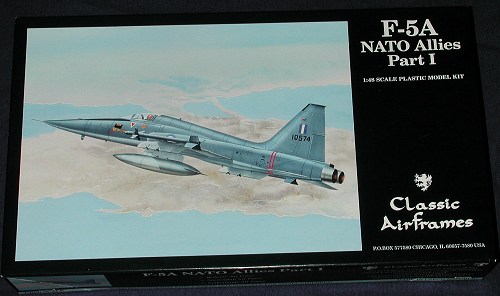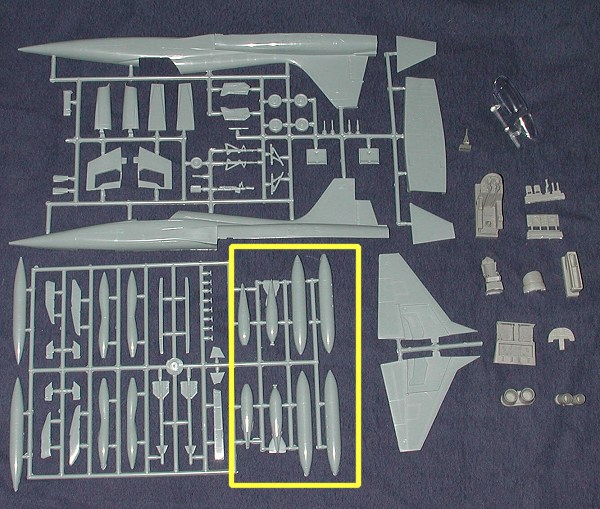
| KIT: | Classic Airframes 1/48 F-5A 'NATO Allies Pt 1' |
| KIT # | 486 |
| PRICE: | $50.00 MSRP |
| DECALS: | Three options |
| REVIEWER: | Scott Van Aken |
| NOTES: | Includes lots of resin parts! |

| HISTORY |
In the mid-1950's, the USAF was looking for a replacement forthe T-33 to be used by air training command. The bidding was fierce as it wasanticipated that this would be a rather large contract. Northrop had beenworking on a lightweight fighter design based on two small afterburning J-85turbojets. These were then incorporated into a slim 'wasp-waist' fuselage withshort, broad wings. The aircraft was over-engineered to improve structuralstrength as it was designed to be fully aerobatic. The landing gear was alsomade stronger than needed, and allowed the use of the aircraft on unpreparedsurfaces. This aircraft became the T-38. It was the first dedicated trainer tobe capable of speeds in excess of Mach 1.
Boosted by the success of this project, Northrop then turned itsattention into modifying the design into a lightweight fighter. Using much ofthe same design components as the T-38, Northrop started work on the N-156F.Emphasis was placed on ease of maintenance, especially engine changes. The F-5has a track and trolley system built into the engine bay to allow easyinstallation and removal of the engine once the tail cone is removed. Inaddition to modifying the forward fuselage for a single seat and 20mm cannon,the wings were enlarged by adding a forward fillet and changing the intakedesign.
As history has shown, the N-156F then became the F-5A and was ahuge success. Though the USAF did not buy the expected number of aircraft,preferring larger, more complex aircraft like the F-4, the F-5 was proven incombat in Vietnam, the initial deployment going under the name Skoshi Tiger.This USAF combat evaluation was a huge success, showing that a small,lightweight aircraft was fully capable of operation in a combat environment.After this, the F-5A was chosen by a large number of foreign countries, severalof them choosing to undertake production licenses. Even today, forty years afterfirst flight, the F-5 continues to provide service.
Sound like you've read it before? Well you have if you've been paying attention. No need to waste an excellent intro!
| THE KIT |

Molded in a medium grey plastic, the kit has very nicely done engraved panel lines. As is the norm with most kits of this type, there are ejector pin towers on many of the larger parts that will have to be removed prior to construction, but it is nothing that the experienced builder will have difficulty with. I'm pleased to note that there is no flash and I did not find any sink areas, this in spite of the plastic of some parts being a bit on the thick side. There is a two-piece canopy, also of plastic that is a bit thick, though it also quite clear.
A bag of resin accompanies the kit and that is used for most of the delicate or detail parts. It includes a superbly molded cockpit tub and seat along with exhaust bits, instrument panel, speed brakes and the speed brake well along with a few other interior pieces.
This particular boxing only has the options of tip tanks or Sidewinders. Other than a centerline tank, there is nothing for under the wings, though the pylons are provided. The area marked in yellow is what is not included. 
Probably the only part of the kit that may need a bit of extra work would be the landing gear and gear doors. While all is there, the detailing is just a tad on the 'soft' side compared to mainstream kits from Revell or Tamiya. Again, nothing major and something that just goes with the territory.
Instructions are well done and show any color or alignment information needed. Also shown is the need for about 1/4 oz of nose weight. Color information is generic with no FS 595 or paint company information given. It is obvious that these instructions are meant for multiple kit boxings as it states that not all parts shown in the parts diagram will be in all kits. As I mentioned earlier, this boxing has no bombs or napalm tanks.
Decals are superbly printed by Microscale and there are markings for three aircraft. First is the box art plane of the Greek Air Force in blue-grey over aluminum. Next is a Norwegian AF aircraft from 332 Sq in overall Aluminum. Finally, a Dutch aircraft in Dark Green and Dark Grey over Light Grey. The upper surface colors are NATO ones and so you may have some trouble finding those pre-mixed. In addition to the unit specific decals, a sheet of data and stripe decals is included and a good placement guide for these is provided.
| CONCLUSIONS |
I would be remiss if I didn't mention something about the NF-5A. As kitted, you cannot build a totally accurate NF-5A. The reason is that these aircraft were built with auxiliary inlet doors or 'shutters' on the aft fuselage. These are just like what is on the F-5E/F. A bit of work with filler and rescribing will provide this feature if you are willing. Also, this aircraft is an early NF-5A as later planes were fitted with prominent flare/chaff dispensers, also on the aft fuselage. They may have had the double-oleo landing gear to give the aircraft a higher angle of attack when taking off and landing, but I'm not 100% positive about that feature. Regardless, this is a really neat kit and I'm sure you'll enjoy building it.
If you would like your product reviewed fairly and fairly quickly by asite that has over 250,000 visitors a month, please contactme or see other details in the